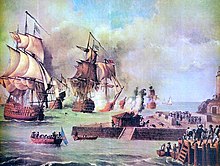Chaloner Ogle
Sir Chaloner Ogle | |
|---|---|
Knight Companion of the Order of the Bath |
Admiral of the Fleet Sir Chaloner Ogle KB (1681 – 11 April 1750) was a Royal Navy officer and politician. After serving as a junior officer during the Nine Years' War, a ship he was commanding was captured by three French ships off Ostend in July 1706 in an action during the War of the Spanish Succession. Ogle was given command of the fourth-rate HMS Swallow and saw action against the pirate fleet of Bartholomew Roberts in the Battle of Cape Lopez in February 1722. The action was to prove a turning point in the war against the pirates and many consider the death of Roberts to mark the end of the Golden Age of Piracy.
In December 1741 Ogle was despatched with a fleet of some 30 ships to support Admiral Edward Vernon in his engagement with Spanish naval forces under Admiral Blas de Lezo off the coast of Colombia during the War of Jenkins' Ear. The attack on Fort San Lazaro was a disaster for the British forces and the Battle of Cartagena de Indias ultimately proved a decisive Spanish victory: 50 ships were lost, badly damaged or abandoned, and 18,000 soldiers and sailors died. Ogle went on to be Commander-in-Chief, The Nore.
Early career
Born to John Ogle, a Newcastle barrister, and Mary (née Braithwaite) Ogle,[1] Chaloner Ogle came from the Kirkley Hall branch of the prominent Northumbrian Ogle family of Northumberland.[2] He joined the Royal Navy as a volunteer in July 1697.[1] He served in the third-rate HMS Yarmouth and then the third-rate HMS Restoration in Autumn 1697 during the Nine Years' War and then served in the fourth-rate HMS Worcester followed by the third-rate HMS Suffolk in 1698.[3] Promoted to lieutenant on 29 April 1702, he joined the third-rate HMS Royal Oak later that month.[3]

Promoted to
Ogle was given command of the fourth-rate HMS Swallow in March 1719 and saw action against the pirate fleet of Bartholomew Roberts in the Battle of Cape Lopez in February 1722.[3] Ogle spotted three of Roberts' ships at anchor and initially pretended to flee: the pirate ship Ranger under Captain James Skyrme gave pursuit and was captured by HMS Swallow. Ogle then went after Roberts' flagship Royal Fortune which was anchored at Cape Lopez: Roberts tried to escape but Royal Fortune received a broadside from HMS Swallow as she passed and Roberts was killed in the action.[3] Ogle was appointed a Knight Companion of the Order of the Bath in April 1723, the only British naval officer to be honoured specifically for his actions against pirates.[4] The action was to prove a turning point in the war against the pirates[5] and many consider the death of Roberts to mark the end of the Golden Age of Piracy.[4]
Ogle was given command of the third-rate HMS Burford in the Channel Fleet in 1729 and of third-rate HMS Edinburgh in the Mediterranean in 1732.[3] Promoted to commodore later that year he became Commander-in-Chief of the Jamaica Station with his broad pennant in the fourth-rate HMS Kingston.[3][6]
Senior command

Promoted to
In December 1741 Ogle was despatched with a fleet of some 30 ships to support Admiral
Promoted to
Family
In October 1714, Ogle married Henrietta Isaacson. After the death of his first wife, he married Jane Isabella Ogle (a cousin) in October 1737; there were no children from either marriage.[1]
References
- ^ required.)
- ^ Dodds, p. 503
- ^ a b c d e f g h i j Heathcote, p. 199
- ^ a b Cawthorne p. 135
- ^ Cordingly, p. 8
- ^ a b Cundall, p. xx
- ^ "No. 7822". The London Gazette. 10 July 1739. p. 1.
- ^ a b c Heathcote, p. 200
- ^ Smollett & Roscoe, p. 606
- ^ Coxe, p. 24
- ^ "Ogle Tales and Trails". Ogle family. Archived from the original on 26 November 2013. Retrieved 4 May 2015.
- ^ "No. 8248". The London Gazette. 9 August 1743. p. 4.
- ^ "No. 8338". The London Gazette. 19 June 1744. p. 8.
- ^ Rayment, Leigh. "Rochester (Kent)". House of Commons. Archived from the original on 19 December 2012. Retrieved 11 November 2010.
{{cite web}}: CS1 maint: unfit URL (link) - ^ "No. 8864". The London Gazette. 4 July 1749. p. 6.
- ^ "Gifford Lodge". Twickenham Museum. Archived from the original on 24 March 2012. Retrieved 4 May 2015.
- ^ "Sir Chaloner Ogle". Twickenham Museum. Retrieved 4 May 2015.
- ^ Dictionary of British Sculptors 1660-1851 by Rupert Gunnis p.338
Sources
- Cawthorne, Nigel (2005). Pirates: an Illustrated History. Capella. ISBN 1-84193-520-4.
- Cordingly, David (1999). Life Among the Pirates: the Romance and the Reality. Abacus. ISBN 0-349-11314-9.
- Coxe, William (1815). Memoirs of the kings of Spain of the House of Bourbon. Vol. 3. London.
- Cundall, Frank (1915). Historic Jamaica. West India Committee.
- Dodds, Madeleine Hope (1929). A History of Northumberland. Vol. XII. The Northumberland County History Committee.
- Heathcote, Tony (2002). The British Admirals of the Fleet 1734–1995. Pen & Sword. ISBN 0-85052-835-6.
- Smollett, Tobias; Roscoe, Thomas (1844). The miscellaneous works of Tobias Smollett. London.
External links
- Chaloner Ogle Three Decks

